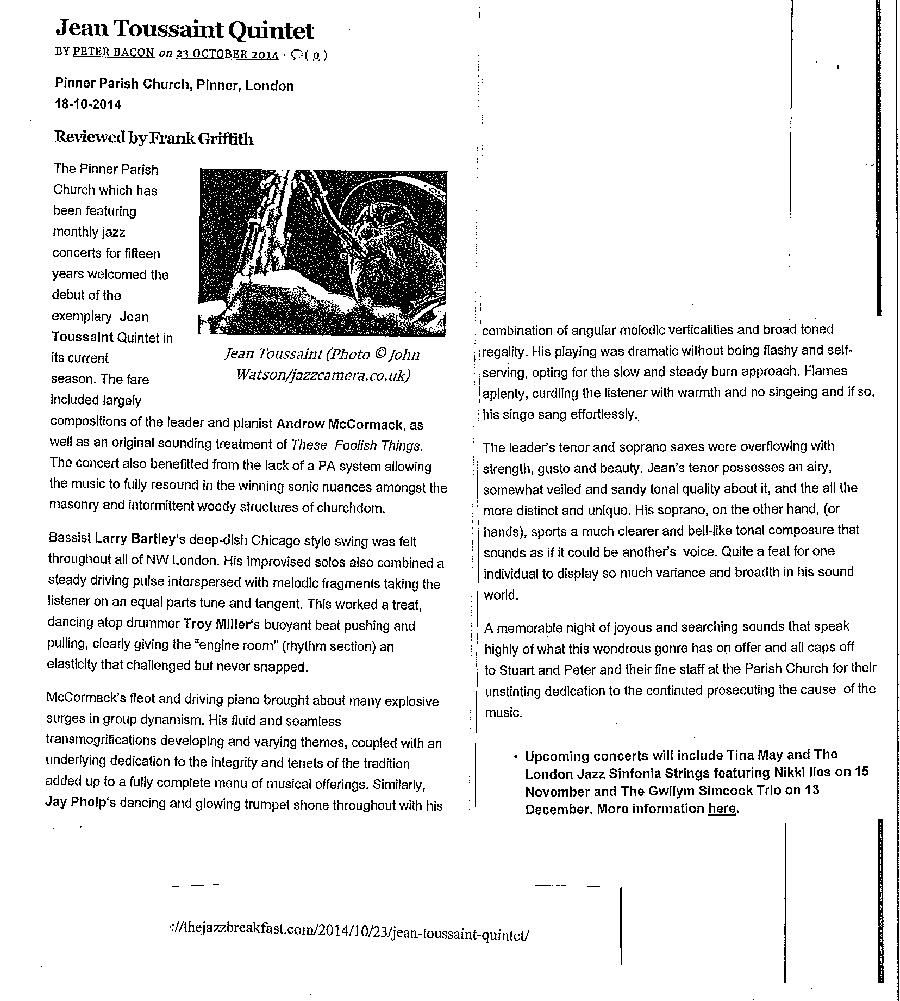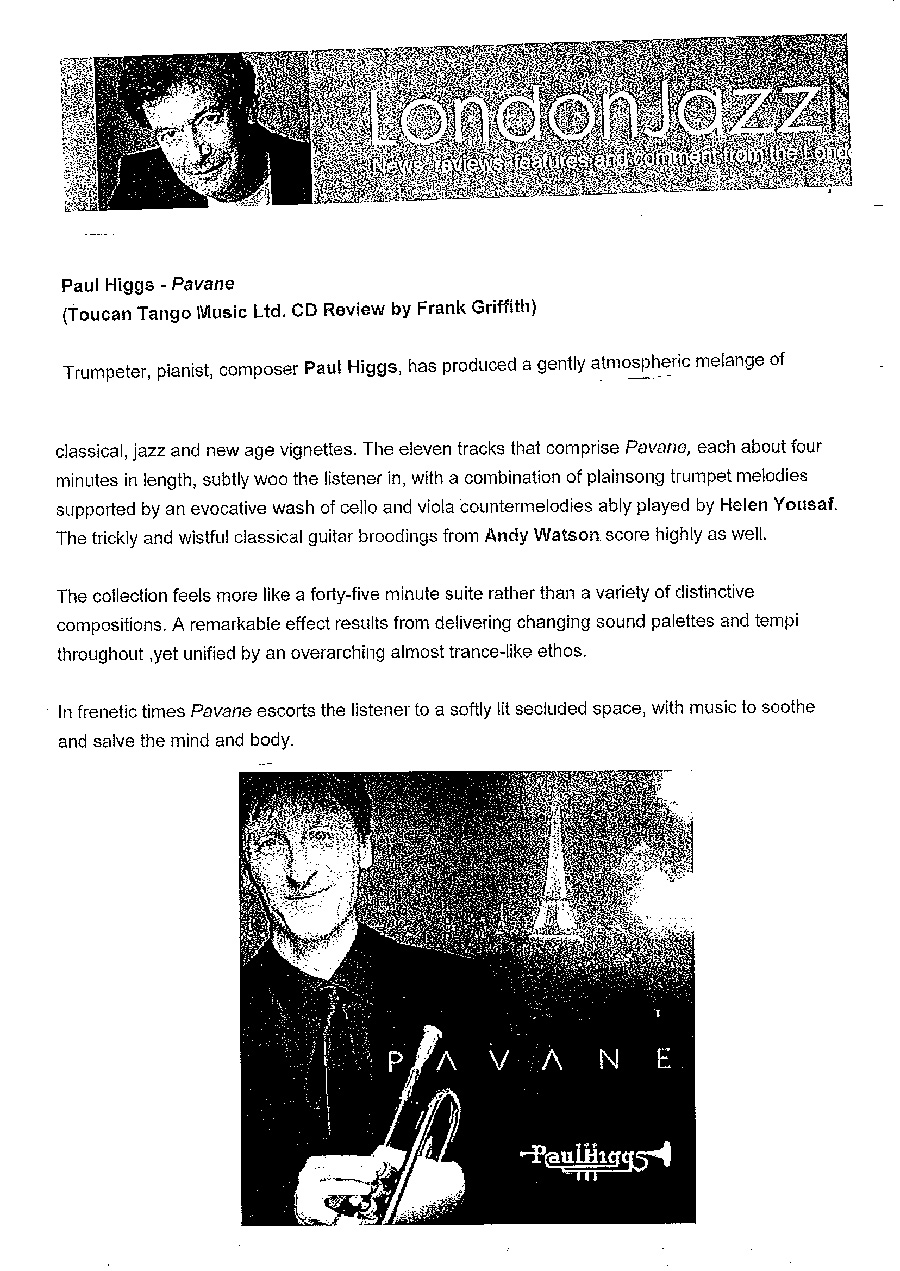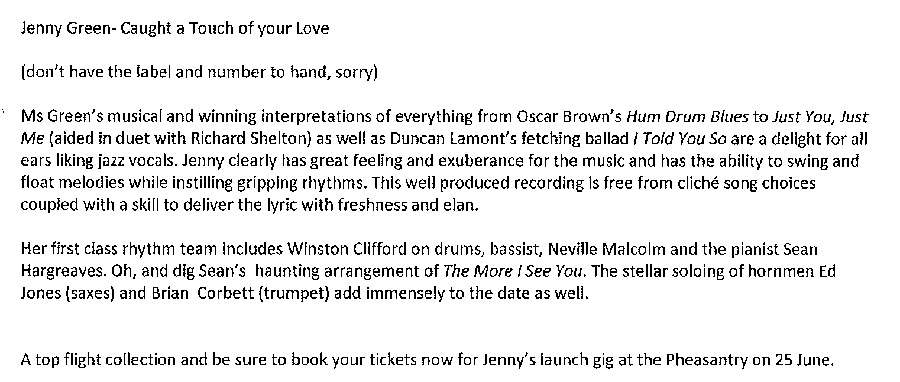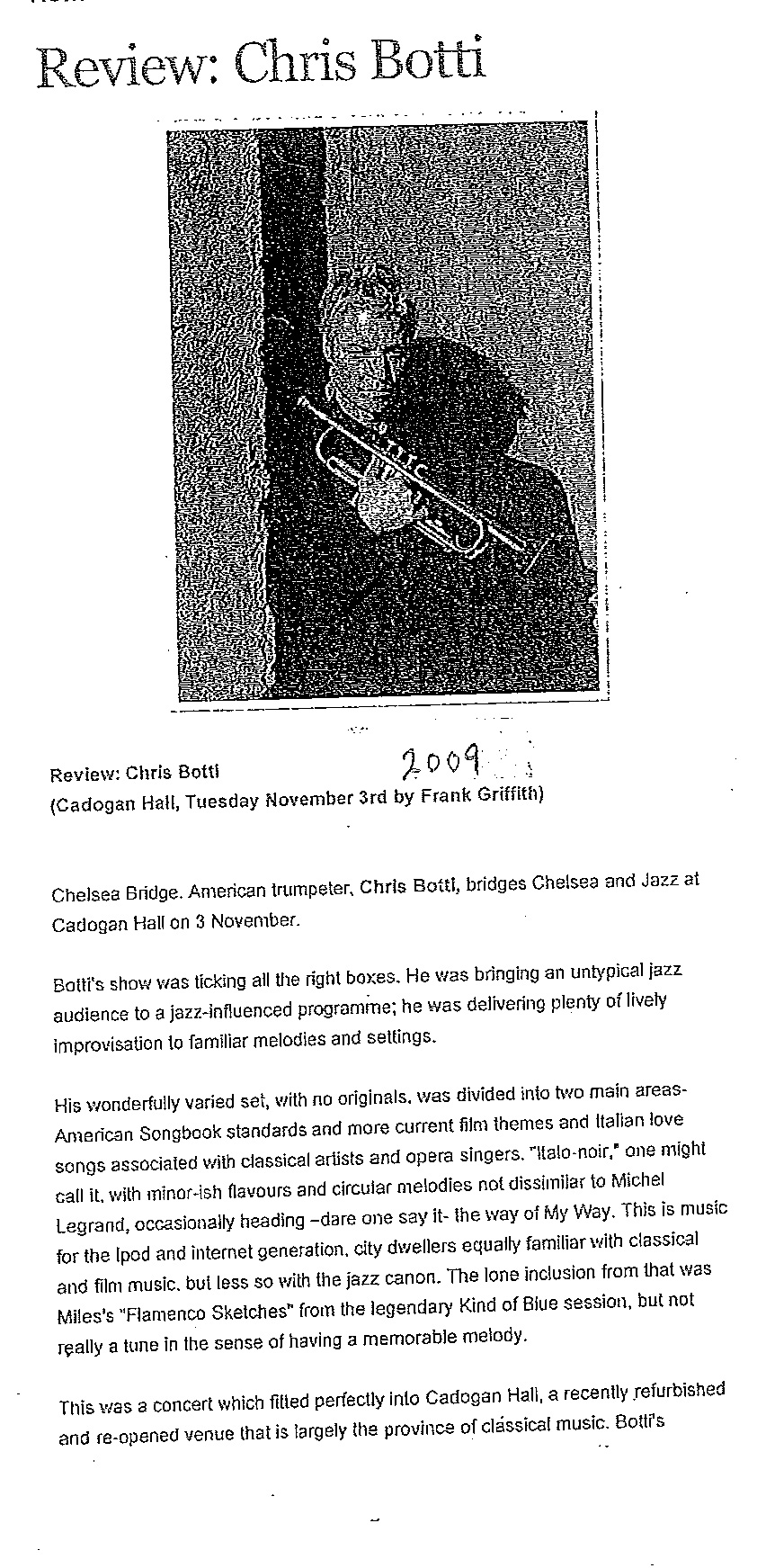Writings
Below are reviews that I have written. Click the plus button to read more.
 Frank G was on holiday in the South of France this week, and took the opportunity to attend one of the evenings of the Nice Jazz Festival, Wednesday 8th July. He writes:
Frank G was on holiday in the South of France this week, and took the opportunity to attend one of the evenings of the Nice Jazz Festival, Wednesday 8th July. He writes:
The show commenced with USA singer, Indra Rios-Moore and her trio of keyboards, bass and a nicely warm-toned tenor saxist and bass clarinettist. More of a folk-flavoured sound but they closed with a spirited rhythmical version of What A Wonderful World.
The clear highlight of the evening was pianist Kenny Barron’s Trio with Kyoshi Kitagawa, bass and Jonathan Blake, drums. Jazz violin fans with know of Jon’s late father, violinist Jon Blake, who played with everyone from McCoy Tyner to Grover Washington. The trio’s opening gamut was a lesser known Monk vehicle, Green Chimneys followed by Barron’s’ Lunacy which also showcased Blake’s percussive fills and generally unrelenting rhythmic “undercurrence”. Not one to ignore classic songs, Barron treated us to an acappella chorus of For Heaven’s Sake and then ushered in the full trio for a series of gently swinging improvised choruses. Bassist, Kitagawa’s deep dish swing coupled with his considered and melodic solos were of particular note on this selection. The set finished with Barron’s Calypso, an appropriate call considering the near sweltering summery Mediterrania environs. It “spread what it said on the tin” as they say – and then some – to climax a more than exhilarating set.
The night concluded with legendary saxist/flutist, Charles Lloyd and his quartet. Lloyd is one of the three remaining near contemporaries of John Coltrane (not that near actually as he was born in 1939 to Coltrane’s 1926) who continue to espouse Coltrane 1960s message of fiery beauty and “calmth” simultaneously. The other two of course are Pharaoh Sanders and Archie Shepp. His set included largely his own compositions including the well known “Sombrero Sam” and “Sweet Georgia Bright”. These were welcome additions to a menu of modal and slowish out of tempo and somewhat self-indulgent pieces that lacked rhythmic ardour and more sprightly group activity and interaction. His trio was magnificent though boasting the talents of Gerald Clayton (son of LA-based bassist and arranger, John Clayton), bassist, Joe Saunders, and eclectic drummer, Kendrick Scott. All outstanding soloists in their own right as well as very supportive and sympathetic to their illustrious and iconic leader.
As an added bonus there was a pre-concert interview with Kendrick Scott and a French journalist with the aid of bilingual writer, American Ashley Kahn (author of the critically acclaimed Kind of Blue: The Making of the Miles Davis Masterpiece chronicling the genesis of the album. The journalist would ask interminably lengthy questions in French (well, it was the Nice Jazz Festival) and Ashley, to his credit would translate and consolidate each one into thirty words or so, in order for Kendrick to be able to sensibly answer it. He did so with eloquence as well, discussing Mike Clark’s role in Herbie Hancock’s Headhunter’s amongst many other innovative drummers contributions to the music. Well done, Ashley, well done,that man.
Pianist, Richard Johnson, a native of Pittsburgh, birthplace of so many jazz legends (Stanley Turrentine, Erroll Garner, Art Blakey and Billy Strayhorn) handled his roles with aplomb, both as accompanist and as soloist. His proclivity to quote was well-noted throughout, with David Raksin’s theme to Laura making more than one appearance. Too bad, then, that fellow quotesters like Jim Mullen or the late Bill Lesage were not on had, they might have given him a run for his money. Veteran bassist, and brother of vocalist, Carmen Lundy, Curtis Lundy, sparkled in his time-keeping as well as his solos. His considered melodic shapes meted out on Sweet Dreams were a grand example of this. Baltimore-born drummer Eric Kennedy gave sensitive support to the soloists, creating subtle and muted moods. By contrast, he demonstrated more flamboyant African polyrhythms on his unaccompanied solos.
Watson’s alto effectively weds his liquid and silky tonal quality with a serpentine-like technique coupled with the application of circular breathing, which is accomplished by inhaling and exhaling concurrently to avoid a break in the sound. Circular breathing is often trotted out as a mere sideshow gimmick by the chancers and the less capable stuntsters; Watson uses it as an intensifier, building up the dramatic flow of both the music and the message.
The penultimate piece of the set, Mal Waldron’s classic, Soul Eyes stood out not least for Bobby’s solo entrance quoting Harold Arlen’s Somewhere Over The Rainbow followed later by Tony Hatch’s Downtown during his brief cadenza at the tune’s close. What these songs (especially the latter) have to do with Soul Eyes is anybody’s guess, but of course an interpreter of this great repertoire associated with this music has full licence to do as he or she pleases. Long may Mr Watson continue to do exactly that, and – please – to come back to Soho sooner rather than later.
Born in Auckland, New Zealand in 1947, Alan immigrated to the USA in 1965 to attend the Berklee School of Music in Boston which pretty much led directly to a 3 year apprenticeship with Woody Herman. He contributed dozens of scores to the Herd library a few of which were performed tonight. Since then, he settled in LA and served as arranger and conductor for many singers like Irene Kral, Natalie Cole, and Diana Krall as well as recently departed bassist Charlie Haden’s Quartet West.
Nightingale’s exemplary band sported a stunning cast of players, too numerous to list but included the likes of trumpeters, Si Gardner and Martin Shaw, the leader’s trombone and saxists Andy Panayi, Sam Mayne and Ben Castle. All were featured healthily in solo roles. Bassist Sam Burgess and the ubiquitous Ian Thomas on drums handled the rhythm chores more than ably.
Not to be underestimated are Alan’s pianistic skills as both a soloist and accompanist. His light-fingered and flawless technique coupled with a rhapsodic expressiveness covering the full range (88 keys and counting) of the “orchestra” of instruments was sublime with its grandeur. His extended solo rendition of Body and Soul as an encore was a stunning example of this. A real tour de force sparkled with modulations, tempo changes and a glorious “codenza” (dramatic ending) to effectively put the evening to bed.
From a writer’s point of view, Broadbent is truly remarkable in his juxtaposition of rich and lush harmonies with orchestration. He frequently utilises orchestral woodwinds (flutes and clarinets) with softer brass textures (mutes, flugelhorns) which helps mellow the somewhat strident harmonies that he employs. This is nicely offset by the full saxy and brassy settings of his in your face bebop swingers such as Sonnys Step (dedicated to the late bop pianist, Sonny Clark) and Bebop and Roses, a staple of the Woody Herman library.
Mr Broadbent was not parsimonious with his addresses to the audience speaking quite movingly of his former leaders, Herman, Haden and Kral. He pointed out that Haden was such an effective bandleader for his ability to put diverse musicians together and create something well above the sum of its parts. He then performed his treatment of a piece he wrote for Quartet West, The Long Goodbye, which had a lyric added by London vocalist, Georgia Mancio, the very first fruits of a songwriting partnership which will have its debut at Pizza Express Dean Street next week.
A glorious night of new sounds provided by the best in the business. Kudos also to Kathryn Shackleton of the Watermill who conceived and organised this tour for Alan and lets hope that this can become an annual event.
Arguably the most proment and innovative modern jazz bassist today, Ron Carter is no mean composer either, and provides ten of his pieces of varying style feel and tempi. They offer ace arranger Richard DeRosa the handy challenge of harnessing this melange of repertoire into the seamless collection that results. Delivering this in stellar form is the WDR Big Band, based in Cologne, a first class ensemble boasting an array of brilliant soloists that include trumpeter, John Marshall; Paul Heller on tenor sax, Johan Hörlen alto sax, and trombonist Ludwig Nuss. Frank Chastenier’s melodic but driving piano solos score throughout alongside the churning battery of Carter’s bass and Hans Dekker’s drums.
The leader’s voice has such a sound and presence that goes well beyond his role in the rhythm section keeping time and goading on soloists.Its as if every note and rhythm and instrumentalist playing them are imbued with Carter’s aura and message sending it well into an atmosphere of larger proportions. On a lighter note, Carter’s playful propensity for quoting runs amok on his solo on “Receipt Please”. He manges to squeeze in a circus call theme, Anything Goes and “All Blues” in as many bars. A feat worthy of a “red card” (in British football parlance) but all the better for his Puckish humour- always welcome in the music.
The magisterial arranging prowess of Rich DeRosa is exemplary throughout. Born and bred in Long Island, New York, Rich is the progeny of the late percussionist and jazz educator, Clem DeRosa. Rich’s other writing credits include the Mel Lewis Jazz Orchestra, Lincoln Centre Jazz Orchestra (dig his swinging vocal chart on “Lullaby of Birdland”)and Gerry Mulligan (with whom he drummed with for many years) as well as a 1980s orchestral jazz concern lead by (Garry) Dial and (Dick) Oatts.
DeRosa’s Thad Jones-like rhythmic swagger and “red note” harmonies on Receipt Please, Blues for D.P. and Cut and Paste score highly in the 1960s/70s modern post Ellington/Basie tradition. For me , the real tour de force though is Sheila’s Song which clearly draws from the sound world of the Gil/Miles 1958 Sketches of Spain collaboration. Not in a pastiche kind of way but more celebrating it in a contemporary fashion.
A flamenco mood is established from the outset with a clever balance of mutes and flutes outlining transparent harmonies that belie their size and shape. One of Gil Evans’ most remarkable skills was to disguise and soften bracing dissonances (close and angular harmonies that could be accused of containing incorrect notes) with an orchestration that soothes and salves. DeRosa has clearly mastered this skill bringing about a distinctive early 20th Century rural Spanish ambience to the proceedings….a “Manuel Defy Ya” vibe if you will…..(sorry..). What is also remarkable is that the composer solidly supplies the repeating ostinato bassline throughout the eleven minute track while allowing guitarist Paul Shigihara, and trumpeter Ruud Breuls to handle the solo spots.They do this magnificently, as well.
This is a CD of epic proportions combining flawless bassistry and distinctive compositions performed brilliantly by the WDR band with DeRosa’s unparalled arrangements. A hallmark CD indeed. Bravo to all hands.
The cream of Seatle’s jazzers are on display here- all of whom contribute equally in solo and ensemble roles. Among those are alto saxist Mark Taylor, bassist, Phil Sparks, Tom Marriot on trumpet and of course the leader’s french horn.
This is Varner’s 14th project as a leader and roughly coincides with his move to Seattle where he teaches at the Cornish Institute (where John Cage, of all people taught many decades ago). Before that, Tom had a long established career in NYC where he was a virtual fixture on the scene being equally employed as a session, orchestral and jazz player. This versatility and command of his instrument clearly show on his remarkable solo on Seattle Blues, an uptempo modal romp.His combination of driving, spirited lines imbued by a somewhat masked and laconic tonal quality welcome and engage the listener while challenging them concurrently.
As most jazz listeners might suspect, the horn has not been overly featured as an improvising voice and, for my money, Varner is the leading exponent of that role in the world today. This tradition began in the late 1950s with people like David Amram and Julius Watkins followed later by Sharon Freeman, Peter Gordon and the UK’s Richard Bissell and Jim Rattigan. Excellent improvisers all as well as the countless others deserving recognition in this area.
I demur breaking down each track: better you should listen to the thing in its entirety. While the parts are superior musicianship, the Varner sum is even greater. Having said this, as an arranger and a Gil-ophile (Evans) I found the CD’s closer, Mele is a particularly riveting and significant track. Boasting a long-form melody with few notes it’s carried on by the cloaked and dissonant harmonic settings that engage the listener in a captively haunting way. This is somewhat ironic as Mele was based on a pop Hawaiian Christmas song originally recorded in the 1940s by Bing Crosby!
There is, as Shakespeare wrote, “nothing new under the sun”, except perhaps, the various organic surprises on this wonderful CD.
What is particularly remarkable about Cathy’s Summer is how well what might initially appear to be a disparate mix of reperotire adds up to such a harmonious blend of selections that binds together this collection well.
The leader’s lyrical, yet emotive elocution of these themes are offset by his focussed rhythmic acuity. This is not unlike his father’s devotion to exploring different time signatures and grooves spurred on with the classic 1959 Dave Brubeck Quartet LP Time Out.
Saxophonist Dave O’Higgins, who not only plays on the date but engineered it as well, sparkles throughout with his clear and penetrating tone aided by a clean and seamless technique. His singing tonal quality goes a long way in delivering the anthemic Brubeck melodies giving them a timeless regality.
The solid rhythmic team of bassist, Matt Ridley, and South African drummer, Wes Gibbens, have been working with Darius for eight years and the teamwork shown as well as comfort with Brubeck’s music is clearly evident here.
Particularly enjoyable for this listener was Brubeck’s clever reworking of the chordal scheme of John Coltrane’s Giant Steps resulting in Cathy’s Summer. It is a refreshing delight, which does not descend into pastiche. Also, dig the touching reading of the Washington/Young chestnut, I Don’t Stand A Ghost Of A Chance With You putting the entire summer of love into context.
As Darius says in his liner note, Cathy’s Summer is dedicated to the fifth member of the quartet, “our creative organiser, motivator, sometime muse and fellow- traveller, Cathy Brubeck.” Hear hear and lets celebrate what this tireless, talented and hard-working woman does for this great music.
From the time that he was a child in California, listening to his mother, a pianist accompanying singers performing Ives vocal works, Jack Cooper , now in his early fifties, has been fascinated by this repertoire. He went on to performing Ives at music school. He then studied with the legendary arranger, Manny Albam in NYC who was very encouraging in Jack’s pursuit of the Ives jazz orchestra project.
Recorded by a A-List NYC band which includes many stalwarts of the Vanguard Jazz Orchestra like saxists, Billy Drewes, trumpeters, Nick Marchione and Scott Wendholt, trombonists, John Mosca, Doug Purviance and Luis Bonilla who also produced the date. Cooper has effectively woven these early 20th Century Ivesian themes in very contemporary sounding excursions of creativity. Top solos abound from the likes of Billy Drewes and Ivan Renta on saxophone, trumpeter Jim Seeley, pianist, Randy Ingram as well as veteran VJO lead trombonist, John Mosca.
Arnold Schoenberg wrote the following in a note discovered posthumously: “There is a man living in this country- a composer. He has solved the problem of how to preserve one’s self and to learn- his name is Ives”
I would also add that there is another man, who grew up just a few miles to the east of where Schoenberg made his home in California, who continues to learn and solve the unanswered question and his name is Cooper. Well done, Jack, as “Mists” will attest.
LINKS: www.PlanetArts.org
Jack Cooper / Ives Facebook Page
On Tuesday, December 30, 2014
Ken Gibson was mainly known as amanuensis to Sir John Dankworth, a role in which he wrote, he copied, he typed, he took dictation, and managed the ‘qnote’ record label. Ken though, was much, much more than this to John, Cleo and Jacqui Dankworth, all of whom he frequently collaborated with.
I met Ken in May 2007 during a mad three days of rehearsing, recording and performing at the Stables in Wavendon. One result of which was Dankworth’s final big band CD “Jazz Matters- The Blues Aint and World Jazz” for the Qnote label on which I had the pleasure on playing on. Amanuensis indeed, as Ken was literally running from pillar to post amongst the cavernous Stables Theatre orchestrating, fixing notes as well as copying and printing off parts of the great man’s scores all of which were hot off the press. Duncan Lamont’s lyrics were sung by Cleo Laine and the all star band boasted the likes of Mark Nightingale, Henry Lowther, Marty Shaw, Andy Panayi, Alan Barnes, John Horler, Alec Dankworth and the late Allan Ganley, to name a few.
Ken and I used to converse by telephone and Facebook frequently. We would also meet at John and Cleo gigs, including a sold out event in February 2008 at the Barbican with the London Symphony Orchestra. He told me that while he was a student ar the Royal Academy of Music in 1969 he requested John to be his arranging teacher. He tole me that after his first (and only) lesson, John called upon him to help him orchestrate his film score to “Perfect Friday”. One lesson then, followed by a forty year career of “amanuensing” for John. It is often the figure behind the scenes that is assumed to be a minor contributor to the outcome – which Ken clearly was not.
Ken played a significant role on Jacqui Dankworth’s 2011 CD,”It Happens Quietly”, which was largely arranged by John. As John passed away in February 2010, Ken stepped in to conduct, arrange and help produce the CD which included strings. One of Ken’s arrangements that stands out for me is his gently loping treatment of “I’m Glad There Is You”. Introduced by a four note bass ostinato figure Jacqui sidles in with her cooly delivered medium tempo take on the melody. This is buffered by a five horn backing riff including horn and bass clarinet. Malcolm Edmonstone’s understated brief solo excursion leads to Jacqui’s re entry on the bridge followed by a subtle upward modulation in the final verse bringing this classic standard to a close.Such a fitting parable for this kind, generous and talented man’s contributions to the music.
RIP Ken Gibson. Your sound and influence will not be forgotten.
What is particularly remarkable about Cathy’s Summer is how well what might initially appear to be a disparate mix of reperotire adds up to such a harmonious blend of selections that binds together this collection well.
The leader’s lyrical, yet emotive elocution of these themes are offset by his focussed rhythmic acuity. This is not unlike his father’s devotion to exploring different time signatures and grooves spurred on with the classic 1959 Dave Brubeck Quartet LP Time Out.
Saxophonist Dave O’Higgins, who not only plays on the date but engineered it as well, sparkles throughout with his clear and penetrating tone aided by a clean and seamless technique. His singing tonal quality goes a long way in delivering the anthemic Brubeck melodies giving them a timeless regality.
The solid rhythmic team of bassist, Matt Ridley, and South African drummer, Wes Gibbens, have been working with Darius for eight years and the teamwork shown as well as comfort with Brubeck’s music is clearly evident here.
Particularly enjoyable for this listener was Brubeck’s clever reworking of the chordal scheme of John Coltrane’s Giant Steps resulting in Cathy’s Summer. It is a refreshing delight, which does not descend into pastiche. Also, dig the touching reading of the Washington/Young chestnut, I Don’t Stand A Ghost Of A Chance With You putting the entire summer of love into context.
As Darius says in his liner note, Cathy’s Summer is dedicated to the fifth member of the quartet, “our creative organiser, motivator, sometime muse and fellow- traveller, Cathy Brubeck.” Hear hear and lets celebrate what this tireless, talented and hard-working woman does for this great music.
From the time that he was a child in California, listening to his mother, a pianist accompanying singers performing Ives vocal works, Jack Cooper , now in his early fifties, has been fascinated by this repertoire. He went on to performing Ives at music school. He then studied with the legendary arranger, Manny Albam in NYC who was very encouraging in Jack’s pursuit of the Ives jazz orchestra project.
Recorded by a A-List NYC band which includes many stalwarts of the Vanguard Jazz Orchestra like saxists, Billy Drewes, trumpeters, Nick Marchione and Scott Wendholt, trombonists, John Mosca, Doug Purviance and Luis Bonilla who also produced the date. Cooper has effectively woven these early 20th Century Ivesian themes in very contemporary sounding excursions of creativity. Top solos abound from the likes of Billy Drewes and Ivan Renta on saxophone, trumpeter Jim Seeley, pianist, Randy Ingram as well as veteran VJO lead trombonist, John Mosca.
Arnold Schoenberg wrote the following in a note discovered posthumously: “There is a man living in this country- a composer. He has solved the problem of how to preserve one’s self and to learn- his name is Ives”
I would also add that there is another man, who grew up just a few miles to the east of where Schoenberg made his home in California, who continues to learn and solve the unanswered question and his name is Cooper. Well done, Jack, as “Mists” will attest.
Born in Auckland, New Zealand in 1947, Alan immigrated to the USA in 1965 to attend the Berklee School of Music in Boston which pretty much led directly to a 3 year apprenticeship with Woody Herman. He contributed dozens of scores to the Herd library a few of which were performed tonight. Since then, he settled in LA and served as arranger and conductor for many singers like Irene Kral, Natalie Cole, and Diana Krall as well as recently departed bassist Charlie Haden’s Quartet West.
Nightingale’s exemplary band sported a stunning cast of players, too numerous to list but included the likes of trumpeters, Si Gardner and Martin Shaw, the leader’s trombone and saxists Andy Panayi, Sam Mayne and Ben Castle. All were featured healthily in solo roles. Bassist Sam Burgess and the ubiquitous Ian Thomas on drums handled the rhythm chores more than ably.
Not to be underestimated are Alan’s pianistic skills as both a soloist and accompanist. His light-fingered and flawless technique coupled with a rhapsodic expressiveness covering the full range (88 keys and counting) of the “orchestra” of instruments was sublime with its grandeur. His extended solo rendition of Body and Soul as an encore was a stunning example of this. A real tour de force sparkled with modulations, tempo changes and a glorious “codenza” (dramatic ending) to effectively put the evening to bed.
From a writer’s point of view, Broadbent is truly remarkable in his juxtaposition of rich and lush harmonies with orchestration. He frequently utilises orchestral woodwinds (flutes and clarinets) with softer brass textures (mutes, flugelhorns) which helps mellow the somewhat strident harmonies that he employs. This is nicely offset by the full saxy and brassy settings of his in your face bebop swingers such as Sonnys Step (dedicated to the late bop pianist, Sonny Clark) and Bebop and Roses, a staple of the Woody Herman library.
Mr Broadbent was not parsimonious with his addresses to the audience speaking quite movingly of his former leaders, Herman, Haden and Kral. He pointed out that Haden was such an effective bandleader for his ability to put diverse musicians together and create something well above the sum of its parts. He then performed his treatment of a piece he wrote for Quartet West, The Long Goodbye, which had a lyric added by London vocalist, Georgia Mancio, the very first fruits of a songwriting partnership which will have its debut at Pizza Express Dean Street next week.
A glorious night of new sounds provided by the best in the business. Kudos also to Kathryn Shackleton of the Watermill who conceived and organised this tour for Alan and lets hope that this can become an annual event.
Hats off to the talents of drummer Matt Fishwick and pianist Nick Tomalin, both stand-out sideman and soloists in their own right. Good on you, Gill, for this latest offering which increases the appetite for the next offering from the Mainstem label.
In addition to his winning four celli arrangement of Kurt Weill’s My Ship, two other songs of Bennett’s, Early To Bed and Goodbye For Now are included in a quintet format. Needless to say, the latter song closes the proceedings giving the collection a poignant send-off without being mawkish or sentimental.
Ms Martin’s voice is ideal for both jazz and popular song with its mellowed huskiness and somewhat veiled tonal quality which is offset by a sharp rhythmic perkiness that suits her material well. Composer/arranger Nigel Waddington, whose 2010 big band CD Bigger Pictures includes Claire guesting on one track states it best when he describes her interpretive skills. “She’s not interested in apeing a particular style, sounding any particular way- smoky, jazzy or whatever…why not? Because she’s too busy inhabiting the song. It sounds like the only thing that she cares about is the music and not how she should be making it sound. It feels like the music is coming straight out of the writer’s brain, channelled through her without picking up any grit, self indulgence or baggage on its journey”. Well said, Nigel.
An outstanding band boasts the likes of Gareth Williams’ fleet and dynamic pianisms along with Jeremy Brown’s lyrical bass which coalesce fittingly with drummer Ben Reynolds’ rhythmic agility. Electric bassist Laurence Cottle makes a guest appearance on his brilliant arrangement of “Round Midnight” which effectively intertwines his unique sound amongst the vertically linear motifs of the first-rate Montpellier Cello Quartet.
Unique treatments abound from the pens of Joe Stilgoe of his song, Lost For Words, Simon Woolf’s reading of My Man’s Gone Now as well as Mark-Anthony Turnage’s take on Joni Mitchell’s Two Grey Rooms. In addition, pianist Geoffrey Keezer’s arrangement of his Featherfall provides a welcome contrast to the programme in summoning up a light and windy ambience portrayed by the flurry of celli in the air.
Bassist, Larry Bartley’s deep dish Chicago style swing was felt throughout all of NW London. His improvised solos also combined a steady driving pulse interspersed with melodic fragments taking the listener on an equal parts tune and tangent. This worked a treat, dancing atop drummer, Troy Miller’s, buoyant beat pushing and pulling clearly giving the “engine room” (rhythm section) an elasticity that challenged but never snapped.
McCormack’s fleet and driving piano brought about many explosive surges in group dynamism. His fluid and seamless transmogrifications developing and varying themes, coupled with an underlying dedication to the integrity and tenets of the tradition added up to a fully complete menu of musical offerings. Similarly, Jay Phelp’s dancing and glowing trumpet shone throughout with his combination of angular melodic verticalities and broad toned regality. Dramatic, without being flashy and self serving opting for the slow and steady burn approach. Flames aplenty, curdling the listener with warmth and no singeing and if so, his singe sang effortlessly.
The leader’s tenor and soprano saxes were overflowing with strength gusto and beauty. Jean’s tenor possesses an airy, somewhat veiled and sandy tonal quality about it and the all the more distinct and unique. His soprano, on the other hand, (or hands) sports a much clearer and bell-like tonal composure that sounds as if it could be another’s voice. Quite a feat for one individual to display so much variance and breadth in his sound world.
A memorable night of joyous and searching sounds that speak highly of what this wondrous genre has on offer and all caps off to Stuart and Peter and their fine staff at the Parish Church for their unstinting dedication to the continued prosecuting the cause of the music. Upcoming concerts will include Tina May and The London Jazz Sinfonia Strings featuring Nikki Iles on 15 November and The Gwilym Simcock Trio on 13 December. Logon to www.pinnerjazz.co.uk for more information.
Moving along quickly, the internationally recognised French jazz pianist, composer and arranger, Frank Amsallem, born in Algeria, raised in Nice and – after two decades in the US – currently resident in Paris, has released his second vocal CD which features an ecclectic collection of largely American popular standards along with Jobim’s Dindi and the leader’s own Paris Remains in My Heart. Franck’s eloquent, yet propulsively emotive and striking piano is joined by the sturdy but lyrically sensitive basswork of Sylvain Romano and the subtly driving drumming of Canadian émigré, Karl Jannuska.
What I find the most special and unique about this offering is the perfectly matched trident of original arrangements, trio concept and fluid vocals throughout. The equal sharing of these three disparate components bring about a winning alchemy resulting in a musical sum greatly outreaching its parts.
Amsallem’s voice is free of pretence and the need to “jazzify” or unnecessarily affect or decorate the written theme, both melodically and lyrically. Essentially delivering the song as the composer intended while taking many liberties with the harmonies and rhythmic undercurrents. Both of which are very much the province and preserve of an arranger of which Amsallem is one of the highest order. Excellent examples of this are on the slower more ruminative songs like Tadd Dameron’s If You Could See Me Now Johnny Green’s Body and Soul and Henry Mancini’s Two For The Road, all of which score highly from Franck’s understated interpretations.
It is my contention that the two most important aspects of a jazz singers’ craft are their rhythmical treatment of the melody and lyric, and the sound and tonal colour of the voice to suit the song’s message. Amsallem captures this to the hilt and effectively sums up his approach with a sentence from his brief liner note. “Indeed, unlike many of my contemporaries, I adore singers and their songs”. Indeed, indeed.
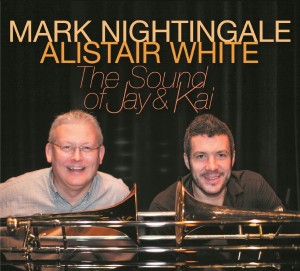 The two -trombone with three rhythm format, in which trombonists JJ Johnson (Jay) and Kai Winding made several albums in the period 1954-1969, is one that is not often heard these days, so all credit to trombonists Mark Nightingale and Alastair White for exploiting this combination, with a crack trio: fleet-fingered yet varied piano stylist, Graham Harvey, the ever-reliable and melodic Alec Dankworth on bass. and ubiquitous drummer Clark Tracey. The listener hearing his driving beat realizes quickly that we are in good hands.
The two -trombone with three rhythm format, in which trombonists JJ Johnson (Jay) and Kai Winding made several albums in the period 1954-1969, is one that is not often heard these days, so all credit to trombonists Mark Nightingale and Alastair White for exploiting this combination, with a crack trio: fleet-fingered yet varied piano stylist, Graham Harvey, the ever-reliable and melodic Alec Dankworth on bass. and ubiquitous drummer Clark Tracey. The listener hearing his driving beat realizes quickly that we are in good hands.
This equally matched “bonesome” is hardly lonesome for excitement and verve as both trombone men possess prodigious techniques coupled with fully rounded and emotive sounds that lift the music well off the paper that it was written on. I must confess to having the occasional difficulty telling them apart initially, although one does detect a grittier tonal quality and somewhat more of a swagger in Nightingale’s solos compared to White’s winsome “sparklularity” and vertically swinging melodic approach. Furthermore, this recording was done in the excellent acoustic of the Norden Farm Centre for the Arts in Maidenhead. What an intelligent move that was as the refreshingly open and live quality that results most likely would have been difficult to establish in a studio setting.
Each of the twelve tracks is equally brilliant in its own way, and the sheer variety of material on offer here deserves praise. Originals by JJ Johnson, Mark Nightingale and the late, Allan Ganley, along with chestnuts from the pens of the likes of Porter, Rodgers, Kern, Noble and Coward. The Great ‘Britamerican’ Songbook if you like. Armstrong’s slow-paced and understated treatment of Cherokee provides an excellent platform for the lyrical bass-work of Dankworth. Similarly, his Blues On The House with its vocalised mutings and interplay amongst the troops coupled with Harvey’s groovy solo left this houseguest fully satisfied.
Jay and Kai indeed, and M and A celebrate this legacy, circa 1958 or so, to the letter(s). Another fine offering from Alan Barnes’ exemplary Woodville label, keeping this vital music alive.
 Sax Appeal’s latest CD Funkerdeen (the title track inspired by “a long night in funky Aberdeen hotel”) provides a tasty mix of funky sax soul from the dean of this genre, leader and saxist, Derek Nash.
Sax Appeal’s latest CD Funkerdeen (the title track inspired by “a long night in funky Aberdeen hotel”) provides a tasty mix of funky sax soul from the dean of this genre, leader and saxist, Derek Nash.
The repertoire includes a wide ranging bevy of post 1970 soul and jazz-derived grooves. There are also a couple of swingers in evidence that lean towards to the boogie blues shuffley end of things. While the leader’s solo work screams and pops throughout, he doesn’t hold back from letting his sidemen flourish as well. The hog callin’ tenor sax cries of Brandon Allen on Funkerdeen contrast well with the raging and soulful pulsations of Scott Garland’s alto on Draggin’ on the Ground.
Tenor man Simon Allen’s cool but funky improvisations score highly along with drummer Mike Bradley’s polyrhythmic finesse on his solo break on Voodoo Rex.
Bari boys, Bob McKay and guest Appealer Alan Barnes, blow up a storm on Blue For You. Bob’s sinewy melodicisms effectively contrast the blustery boptimisms of Barnesy in a good old fashioned battle of the bari good. Just as a side note, McKay has often credited fellow West Country lad, John Surman as a major influence as both of the Cornwall-bred multi-octavists have gone to great lengths to extend the natural range of the instrument, a musical ladder which they in turn have inspired and motivated many up-and-coming baritonists to climb.
A snappy cameo from boogie woogster and longtime Nash employer, pianist, Jools Holland sprinkles a welcome dollop of ex-Treme grit to the proceedings on Sticky Finger Boogie.
To resume, just a super duper sesh celebrating the joys of saxys to the maxys. Celebrating their 35th year above ground, Sax Appeal must be doing something right as the fruits from this most recent offering clearly prove.
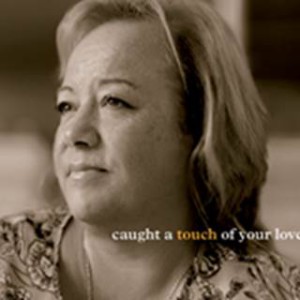 Jenny Green’s musical and winning interpretations of everything from Oscar Brown’s Hum Drum Blues to Just You, Just Me (aided in duet with Richard Shelton) as well as Duncan Lamont’s fetching ballad I Told You So are a delight for all admirers of jazz vocals.
Jenny Green’s musical and winning interpretations of everything from Oscar Brown’s Hum Drum Blues to Just You, Just Me (aided in duet with Richard Shelton) as well as Duncan Lamont’s fetching ballad I Told You So are a delight for all admirers of jazz vocals.
Jenny clearly has great feeling and exuberance for the music and has the ability to swing and float melodies while instilling gripping rhythms. This well produced recording is free from cliché song choices coupled with a skill to deliver the lyric with freshness and élan.
Her first class rhythm team includes Winston Clifford on drums, bassist, Neville Malcolm and the pianist Sean Hargreaves. Dig Sean’s haunting arrangement of The More I See You. The stellar soloing of hornmen Ed Jones (saxes) and Bryan Corbett (trumpet) add immensely to the date as well.
 Strength In Numbers, indeed, as this Connecticut born, NYC-based trombonist/arranger’s second big band CD shines on many levels. Pete McGuinness nods to the late Bob Brookmeyer, as well as other jazz icons (Thad Jones and Chet Baker) are evident while never overshadowing his well formed individual voice as a writer, trombonist and singer.
Strength In Numbers, indeed, as this Connecticut born, NYC-based trombonist/arranger’s second big band CD shines on many levels. Pete McGuinness nods to the late Bob Brookmeyer, as well as other jazz icons (Thad Jones and Chet Baker) are evident while never overshadowing his well formed individual voice as a writer, trombonist and singer.
His wise combination of largely originals with three carefully chosen standards make for a delectable collection that joins together seamlessly. The crack NYC band sparkles throughout, boasting a fleet of inspired and virtousic soloists coupled with exemplary ensemble prowess. They negotiate through the leader’s challenging, yet highly rewarding charts with unfettered aplomb.
Standout soloists, to name a few include veteran trumpeter, Chris Rogers whose lyrical harmon muted heartfelt melodies score highly on “Spellbound”. Fans of the 1970s movie, “Fame” might remember Chris’s bit part in that film as a student who suddenly could not resist the urge to dance atop a cafeteria table during lunch. Tenor saxist, Tom Christensen’s beefy but clear toned sinewy excursions also prevail on the opening track “The Send Off”. This was a tribute piece to Brookmeyer who had a significant influence on McGuinness having studied with the great man as a member of the BMI Jazz Composers Workshop in the late 1980s. Not to be outdone, the spirited yet perplexing trombone tradings of Mark Patterson and Matt Havilland followed by the emotive and melliflous offerings of Bill Mobley’s trumpet help make the leader’s “Nasty Blues” anything but. Finally, would someone please confiscate the alto sax from Dave Pietro’s hands as he completely mops the floor with his blinding solo on “Nasty” as well.
In addition to his passionately played trombone feature on “Trixie’s Little Girl” (dedicated to his late mother, Anne) Pete’s vocals glow on two standards, “What Are You Doing The Rest Of Your Life” and “You Don’t Know What Love Is”. Free of vibrato or affectations, his clear and winningly light textured vocal quality delivers the goods with a subtle intensity. This fine singing is complemented grandly by his embracing ensemble treatments of these classic songs.
Numbering the strengths of this quality recording would be a job indeed as they are countless. A truly inspired and brilliant addition to the modern big band sound while incorporating the traditions that built it. A stellar effort.
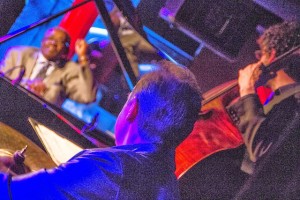 Jazz Legend, pianist, Larry Willis made a rare visit to London leading a quartet that brought much glee to an ample crowd at Soho’s finest basement jazz venue, Pizza Express. The exemplary talents of Irish guitarist, David O’Rourke (who has been resident in NYC since 1983) and fellow Irish drummer, Stephen Keogh, were joined by top British bassist, Jeremy Brown.
Jazz Legend, pianist, Larry Willis made a rare visit to London leading a quartet that brought much glee to an ample crowd at Soho’s finest basement jazz venue, Pizza Express. The exemplary talents of Irish guitarist, David O’Rourke (who has been resident in NYC since 1983) and fellow Irish drummer, Stephen Keogh, were joined by top British bassist, Jeremy Brown.
Their set consisted of a wonderfully varied mixture of classic standards and Willis originals. These included Children of Harlem (where Willis grew up), a lyrical jazz waltz that developed into a driving modal excursion exploiting Willis’ improvisatory expressions.
His “To Wisdom the Prize” also modal in nature was eloquently introduced with a solo piano foray that included nods to Nat King Cole’s “Nature Boy”. Not surprising as Willis’ 1992 Steeplechase CD “Unforgettable” was a dedication to ballads associated with Cole.
The uptempo Dietz/Schwartz classic Alone Together kicked off the set with a fetching arrangement by Willis. It juxtaposed a lyrical stating of the first eight bars of the tune then was followed by a jagged rhythmical answering phrase thus providing an effective contrast for the listener of this well worn chestnut.
David O’Rourke’s rich and mellifluous guitar tone was showcased wonderfully on his solo rendition of A Certain Smile from the self-titled 1958 film: Composed my Fain/Webster it was originally recorded by Johnny Mathis and Mr O’Rourke gave it his own unique jazz treatment. If that wasn’t enough, he cannily inserted quotes from London By Night in the closing passages. It seemed an appropriate celebration of the Dublin-born guitarist’s début performance in this great city.
The sterling basswork of Jeremy Brown scored highly including many fine solos as well as the driving yet sensitive percussion talents of O’Rourke’s longtime musical pal, Stephen Keogh. In addition to his playing, Willis’ warm and gently manner with the audience with his “fireside chats” went a long way to establishing a memorable dynamic. He encouraged the punters to buy a CD with the caveat that “if you don’t like it then give it to someone that you DON’T like.”
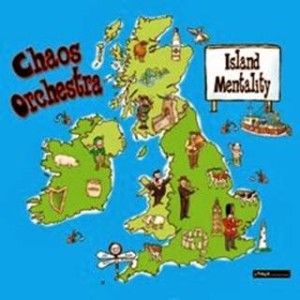 The Chaos Orchestra’s début CD Island Mentality showcases the compositions of Laura Jurd, Simon Marsh and Alex Roth. An eclectic mix to be sure, with an angular, rhythmically complex take on the conventional big band line-up with a clarinet and flute added. The distinctive vocal talent and interpretations of Lauren Kinsella contribute richly to the mix as well.
The Chaos Orchestra’s début CD Island Mentality showcases the compositions of Laura Jurd, Simon Marsh and Alex Roth. An eclectic mix to be sure, with an angular, rhythmically complex take on the conventional big band line-up with a clarinet and flute added. The distinctive vocal talent and interpretations of Lauren Kinsella contribute richly to the mix as well.
This outstanding band draws largely from the forces of recent graduates of the exemplary jazz course at the Trinity Laban. Time doesn’t allow discussion of each of the excellent eight tracks; I found Laura Jurd’s four offerings the most distinctive and refreshing. The eminent saxophonist and composer, Mark Lockheart, also makes brief cameos as both composer and soloist.
A young, vibrant ensemble with a quirky and humorous side yet not lacking in depth or love for the craft. Chaos models a sound and approach not dissimilar to Manchester’s Beats and Pieces but perhaps more along the lines of “Piecemeal Beatings” of the big band canon. Albums such as this move that tradition forward, and in a fashion which is unique, inspired,…..and necessary.
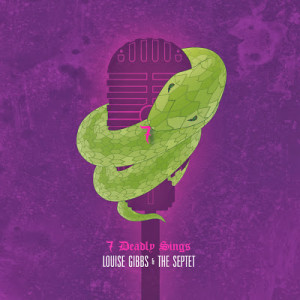 Vocalist and composer, Louise Gibbs, has turned out an ambitious and challenging fifty minute “song suite for jazz singer and septet” that succeeds on many counts. The 7 Deadly Sings accords a sin for every instrumentalist in the septet to express themselves on. (My favourite is the bassist being Sloth – but that’s not very nice, or fair, now is it?).
Vocalist and composer, Louise Gibbs, has turned out an ambitious and challenging fifty minute “song suite for jazz singer and septet” that succeeds on many counts. The 7 Deadly Sings accords a sin for every instrumentalist in the septet to express themselves on. (My favourite is the bassist being Sloth – but that’s not very nice, or fair, now is it?).
The distinctive cast of players that Ms Gibbs has assembled here acquit themselves to the task at hand exquisitely. Tim Whitehead’s brooding and moody tenor sax scores highly on Lust and Tom White’s egregious gutbucketings on trombone are just the job for Gluttony. Not to be outdone, the wistful, yet rich-toned florid melodicism of Toni Kofi on the alto sax deliver the goods on Greed. The remainder of the soloists fully realise their respective sins as well and all serenaded by Louise’s looming vocal commentaries . An equal combination of scat, vocalese and lyrics done over a varied suite of tempi, feels and moods.
Deadly singing, you might say, in the most sinful of manners and settings, as only Louise can do. A daring and innovative project, to say the least, but in the end a victorious one, which finds truth in the old saw about the devil having the best tunes.
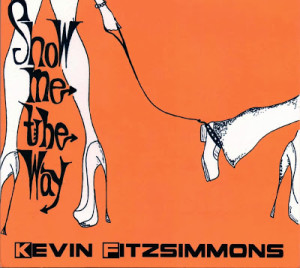 Vocalist, Kevin Fitzsimmon’s début CD, Show Me The Way has illuminated this listener’s path with gusto. The album sports a blend of popular fare, with Kevin’s own fetching songs and lyrics. His rich and resonant vocal quality hearkens the post-1950s sounds of Matt Monro and Steve Lawrence with an extra dollop of East London-cum-Essex edgy crust. It all adds up though: his understated delivery makes the less-is-more approach pay back.
Vocalist, Kevin Fitzsimmon’s début CD, Show Me The Way has illuminated this listener’s path with gusto. The album sports a blend of popular fare, with Kevin’s own fetching songs and lyrics. His rich and resonant vocal quality hearkens the post-1950s sounds of Matt Monro and Steve Lawrence with an extra dollop of East London-cum-Essex edgy crust. It all adds up though: his understated delivery makes the less-is-more approach pay back.
A more than capable, all-star London lineup includes stalwarts like flautist, Gareth Lockrane, trumpeter, Steve Fishwick and saxman, Alex Garnett. Juggling three keyboards, Leon Greening acquits himself admirably with effective turns on Fender Rhodes and Wurlitzer. Ahh,…the glorious 60s and 70s. Recording engineer, multi-saxist and co-writer of two of Fitzsimmmon’s songs, Derek Nash, plays no small part in this offering as well.
There is a wide range of repertoire in this songfest including Strayhorn’s “Lush Life” to McCartney’s “Norwegian Wood”, plus the leader’s title song and his engaging opener, “Blues For You”. This nifty 12-bar has a clever set of alternative blues changes penned by Nash.
“Show Me the Way”, indeed. What a gas to be aboard, what a journey to be on.
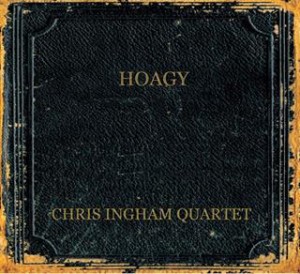 Pianist, vocalist, Chris Ingham’s CD “Hoagy” on Downhome Records showcases his talents on sixteen of Mr Carmichael’s finest songs. These include well known chestnuts like Georgia on My Mind, Skylark and Stardust as well as lesser known gems like Memphis in June and Lazy Bones. He even manages to toss in Dave Frishberg’s Dear Bix, certainly a welcome addition.
Pianist, vocalist, Chris Ingham’s CD “Hoagy” on Downhome Records showcases his talents on sixteen of Mr Carmichael’s finest songs. These include well known chestnuts like Georgia on My Mind, Skylark and Stardust as well as lesser known gems like Memphis in June and Lazy Bones. He even manages to toss in Dave Frishberg’s Dear Bix, certainly a welcome addition.
This outstanding quartet includes Rev. Andrew Brown on bass, drummer, Russ Morgan along with Ingham’s able and sparkly piano doing double duty accompanying his vocals as well as providing inspired solo forays. Rounding out the group is Paul Higgs’ wistful but puckish trumpet flutterings that appropriately help to celebrate Hoagy’s sardonic wit.
Chris’ somewhat light and streamlined vocal quality is infused with a covering of Midwestern dustiness- just the job for this kind of material. One gets the sense that he revels in the opportunity to share these songs with whomever might be in his midst- whether in a concert hall or informal house party.
The nifty and concise arrangments are ideal for this varied collection, yet never sound short changed or predictable.
A fine delectation of Hoagy delights conveyed masterfully by an able foursome.
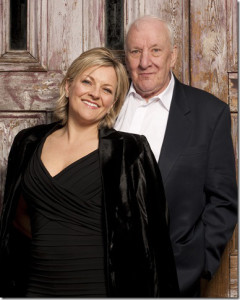 Kicking off the 2012 London Jazz Festival on 11.11.11 was jazz chanteuse, Claire Martin accompanied by the celebrated composer, songwriter, pianist and crooner,Sir Richard Rodney Bennett.
Kicking off the 2012 London Jazz Festival on 11.11.11 was jazz chanteuse, Claire Martin accompanied by the celebrated composer, songwriter, pianist and crooner,Sir Richard Rodney Bennett.
An ideal venue, too, the Forge is parked in a bustly section of Camden, and is ably run by Adam and Charlotte Caird. It occupies a high-ceilinged, square-shaped, woody space and boasts a wall of tall windows across from the stage that give the impression of enlarging the space further. Awash with pastel rose-coloured lighting, it’s just the right ambiance for an idyllic evening of song.
Claire Martin’s voice is ideal for both jazz and popluar song. It’s somewhat veiled and husky quality is offset by a sharp rhythmic perkiness that suits her repertoire well. She moves light-footedly on stage, but never at the expense of distracting the listener from the music.
The two musicians share the introductions and anecdotal tidbits, background and history. That is effective and well-judged too. “Jabaret?” Or maybe not….
The main theme was the music of Irving Berlin which incuded his classics like Cheek to Cheek, Puttin on the Ritz, Change Partners and How Deep is the Ocean, but lesser known gems as well. Outstanding amongst these were Claire’s poignant renditions of I Got Lost in his Arms (perhaps his greatest song- for this writer anyway) and Fools Fall In Love.
Similarly, Richard’s takes on Say It Isn’t So and He Aint Got Rhythm (A satire on Gershwin’s I Got Rhythm) also scored with his uniquely low key interpretations. His vocal sound mirrors Ms Martin’s mellowed huskiness but differs in his somewhat less precise adherence to the written melody giving it a relaxed, come what may quality about it. Their duets were also effective, no doubt because of this affinity and blend of sound that they achieve together. More of these would have been welcome.
About midway through the second set they wisely added other composer’s works including Cy Coleman (Witchcraft, The Best Is Yet To Come) a Dusty Springfield song and the immortal A Nightingale Sang in Berkeley Square. Mr Bennett’s refreshing treatment of this was done with a lightly loping waltz feel that worked exquisitely.
Another delight was their pairing together similarly titled songs into seamless medleys. Couplings like Isn’t It A Lovely Day and It’s A Lovely Day, Today; Shakin the Blues Away and Blue Skies; and The Very Thought of You and I Thought About You worked a treat.
A first class evening of song that so effectively set the stage for the impressive ten-day London Jazz Festival programme. Long may it live and prosper.
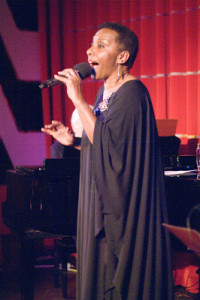 Jazz singer extraordinaire Elaine Delmar presided brilliantly at the newly opened Crazy Coqs cabaret venue in the Brasserie Zedel complex in Piccadilly. It’s heartwarming to see that her stint is running a full week (Tuesday- Saturday) with this being the opening night. This harks back to the time when all gigs of this nature were week long residencies, a rarity nowadays.
Jazz singer extraordinaire Elaine Delmar presided brilliantly at the newly opened Crazy Coqs cabaret venue in the Brasserie Zedel complex in Piccadilly. It’s heartwarming to see that her stint is running a full week (Tuesday- Saturday) with this being the opening night. This harks back to the time when all gigs of this nature were week long residencies, a rarity nowadays.
Supported by pianist Brian Dee and Jim Mullen on guitar, Miss Delmar was in top hands throughout as their accompanying skills were evenly matched by their refreshingly inspired solo forays.
Performing a largely Gershwin programme, Delmar provided the audience with bits of chat about the songs without evolving into lecturing or overegging the pudding. She delivered what the punters wanted. Songs. Her voice and interpretations did not disappoint as her poised elegance achieved an equal balance of emotion and technical perfection. The inclusion of a few non-Gershwin selections also brought out her versatility. Amongst these were a whirlwind reading of Noel Coward’s Mad Dogs and Englishmen as well as a (double) encore of Murray Grand’s Guess Who I Saw Today (from Broadway’s New Faces of 1952 revue) and Fats Waller’s Honeysuckle Rose to finally close the proceedings. Elaine’s eighty minute show included no less than twenty songs most of which were quite familiar Gershwin titles and clearly satisfied both camps- the jazzer and the “cabaret-ster”.
For this listener, particularly memorable moments were Isn’t It A Pity with Delmar’s searching vocal supported by Jim’s “Mullencholy” guitar. Never one to resist an opportunity to sneak in a cheeky quote he managed a brief oriental fanfare in reaction to the lyric “Somewhere in China” at the end of the bridge. Classic. The trio’s version of Love Walked In featured a spirited and rollicking solo from Brian Dee, highly regarded as a top vocal accompanist, and longtime pianist with Elaine Delmar.
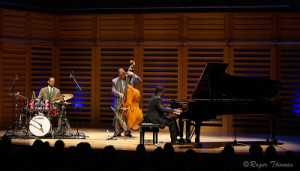 For their first set, the Marcus Roberts Trio and the Guildhall Jazz Orchestra directed by Martin Hathaway collaborated on a selection of Ellington and Basie big band chestnuts such as Koko, In A Mellow Tone, Main Stem, Lil’ Darlin and The Kid From Red Bank. The students rose to the occasion well. Their ensemble playing was of very high quality, and they fielded an impressive bevy of creative and fleet soloists. Martin Hathaway’s supportive and encouraging conducting manner was hugely additive, providing swells, diminuendos, his manner of directing the band was subtle but highly effective. This is an essential role and responsibility for a guiding a large ensemble and Martin fulfilled it with aplomb. One quibble: I found that the lack of a written programme was regrettable, meaning that I cannot name check the GJO soloists.
For their first set, the Marcus Roberts Trio and the Guildhall Jazz Orchestra directed by Martin Hathaway collaborated on a selection of Ellington and Basie big band chestnuts such as Koko, In A Mellow Tone, Main Stem, Lil’ Darlin and The Kid From Red Bank. The students rose to the occasion well. Their ensemble playing was of very high quality, and they fielded an impressive bevy of creative and fleet soloists. Martin Hathaway’s supportive and encouraging conducting manner was hugely additive, providing swells, diminuendos, his manner of directing the band was subtle but highly effective. This is an essential role and responsibility for a guiding a large ensemble and Martin fulfilled it with aplomb. One quibble: I found that the lack of a written programme was regrettable, meaning that I cannot name check the GJO soloists.
Marcus’s trio was dynamic and dizzying with the solidly swinging and fully rounded bass lines of Rodney Jordan along with the light touch and supportive percussion of Jason Marsalis, the youngest of the four brothers from that historic and influential jazz family from the Crescent City. The good vibes that the trio projected outwards (to audience and the big band) could be summed up in Mr Jordan’s gleeful encouragement of fellow student bassist from the GJO while they swapped choruses walking basslines. Such support and positivity is contagious.
Pianist Roberts is a force of nature with his ebullient touch, and his mastery of so many idioms throughout the decades of jazz piano. His contribution went from light-fingered fills on Lil Darlin, through a powerful two-handed “octavising” in The Kid From Red Bank, to brief but memorable solo boogie woogie excursion in the second half. Also,his ability to remember and fully aknowledge the names of all the GJO soloists was remarkable, admirable, generous and noteworthy.
The second set featured a handful of Robert’s pieces for a smaller ensemble consisting of five saxes and four brass which posed too extreme a contrast for this listener in comparison to the first set. These pieces were much more vehicles for improvisation and lesser exercises for jazz composition. The addition of New Orleanian trumpeter, Etienne Charles, however, brought something very special to the party. His melodic swing and swagger coupled with his big and rich tone enhanced the proceedings with a bravado that brought the evening to a winning finish.
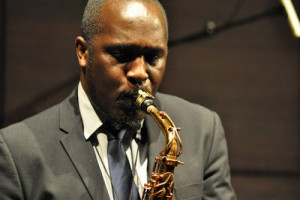 The St James Theatre Studio on Palace St near to Victoria Station is a new and welcome venue for Jazz. James Albrecht, the Associate Artistic Director responsible for the Studio Bar has wisely enlisted sometime thespian and jazz pianist, Dorian Ford, to curate a Friday night jazz concerts series, and what a fine job he has done so far. Boasting seating capacity for 120 the main room is laid out well with tables and comfy chairs, a handy bar and very helpful staff who are not ominpresent or overbearing. There is also upper balcony seating for those who prefer a higher angle on things as while there is a full PA present the overall sonic ambience of the room is organically an acoustical one.
The St James Theatre Studio on Palace St near to Victoria Station is a new and welcome venue for Jazz. James Albrecht, the Associate Artistic Director responsible for the Studio Bar has wisely enlisted sometime thespian and jazz pianist, Dorian Ford, to curate a Friday night jazz concerts series, and what a fine job he has done so far. Boasting seating capacity for 120 the main room is laid out well with tables and comfy chairs, a handy bar and very helpful staff who are not ominpresent or overbearing. There is also upper balcony seating for those who prefer a higher angle on things as while there is a full PA present the overall sonic ambience of the room is organically an acoustical one.
The Tony Kofi Quartet presented an exciting and eclectic programme with pieces by Wayne Shorter, George Adams, Thelonious Monk and Chick Corea as well as the classic standard, If I Should Lose You. Their refresing take on this chestnut borrowed from a 1980s quartet in NYC called Sphere (with Kenny Barron and Charlie Rouse) and their treatment of the same song.
The leader’s alto sax combines a rich mix of tonal influences from the likes of Sonny Stitt and James Spaulding coupled with the dry wistfulness of Sonny Criss if not a dollop of the tubby jocularity of the late James Moody. He sports a full tone throughout the entire contours of the horn and is not afraid to display his circular breathing skills. These allow him to not break his tone or phrase in order to inhale more air, a technique often resorted to by lesser players as an end of pier, sideshow like gimmick that one can tire easily from. Mr Kofi only employs it sparingly though and musically effectively at that. His Moody-like humour was evident in his many quotes, most notably Exactly Like You during his solo on George Adams’ Flower For A Lady.
The fine trio showcased the talents of pianist, Trevor Watkiss, who rose to the occasion admirably tackling several new pieces with aplomb. His supportive accompanying skills were matched by his lyrical melodicsms and sensitive touch. The deeply swing bassist, Larry Bartley, provided the bulk of the engine room responsibilities for the group as well as contributed some credible solos. His fluent melodies were enhanced by his strongly percussive and insistent rhythmic integrity. 20 year old drummer, Moses Boyd, is clearly a face for the future with his light but driving touch and general attentiveness to all matters ensemble. His fluid and ringing tone on his ride cymbal went a long way to instilling a fully swinging comfort zone from the rhythm section.
An excellent evening of jazz by an exemplary quartet in a most ideal of settings. Do access the St James Theatre sooner rather than later and book yourself in for their upcoming season of Jazz on Fridays.
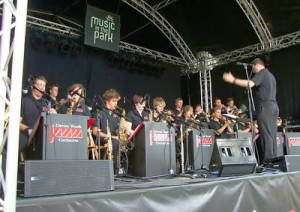 At last night’s Will Michael Awards ceremony held at the Royal Academy of Music, Diplomas for outstanding achievements in jazz education in 2011/12 were awarded to:
At last night’s Will Michael Awards ceremony held at the Royal Academy of Music, Diplomas for outstanding achievements in jazz education in 2011/12 were awarded to:
East Renfrewshire
One Education Music (Manchester)
Oxfordshire
SoundStorm (Bournemouth and Poole)
Southampton
A Diploma of Special Merit was given to Devon together with a special trophy donated by Yamaha Music Europe – UK, in recognition of the fact that Devon have now won six Diplomas on the trot, four of them of Special Merit.
The Will Michael Awards are part of the National Music Council Local Authority Music Education Awards Scheme, and are supported by Yamaha Music Europe. More background to the awards is HERE
The awards were presented by:
Prof Jonathan Freeman-Attwood – Principal of the Royal Academy of Music
Juliette Kelly – Trustee of Jazz Services
Mike Ketley – Yamaha.
==========================================
The Awards Presentation was followed by a performance; Frank Griffith Writes:
I attended a concert last night at the Royal Academy of Music in London presenting a programme entitled The Lost Kenny Wheeler Scores, performed by The Academy Big Band conducted by Nick Smart;The soloist playing the role of Kenny was the eminent British trumpeter and flugelhornist, Henry Lowther. The concert included several pieces from the 1960s and early 1970s, lesser known big band works by Kenny Wheeler from the Academy’s newly acquired archive. The titles will be familiar to Kenny Wheeler fans although more as small group pieces. They included:
Ticketeeboo
Introduction to no particular song
Foxy Trot
Heyoke
Smatta
Mabelle
Who Are You (lyrics by Norma Winstone)
The band performed these works brilliantly in both their ensemble playing as well as solo forays. Fourth year vocalist, Emma Smith, acquitted herself admirably on Norma Winstone’s Who Are You.
As is often the case with great and important writers their signature sound and strengths are often established early, as was also the case with Gil Evans’s scores for Claude Thornhill in the 1940s. His orchestrations (use of horns, tuba, flutes, clarinets) and counterlines were being put to use well before his epical scores for Miles on Columbia in the late 1950s. Similarly, Kenny’s rich harmonies and rhapsodic melodies borne out with open brass and saxes were fully evident in these relatively early works of his.
Just to give one an idea of the significance of the occasion, many key figures from British jazz were in the audience including Stan Sulzmann, Pete Hurt, Dave Green, Juliet Lewis, Phil Robson and Mark Armstrong.
A beautiful hour of music indeed.
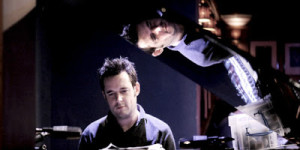 The Tim Lapthorn Trio were making their debut at this venerated Soho nightclub, launching the new album Transport (Pathway Records), and embarking on an album launch tour. They brought with them an olio of different musical timbres and colours: a string quartet, an illustrious tenor saxophonist, and a guest vocalist. Tim Lapthorn’s pianistic abilities include a formidable technique and delicate touch, a wonderfully rich tone from the instrument. His equal command of strong melodicism, a loamy harmonic sense and an acute rhythmical drive make him the consummate jazz pianist. One particularly remarkable quality is his mounting of intensity in his solos creating cascades of tumultous rhythmic dynamism from the trio, which can then, at will, be simmered down quickly to a quiet close. Bassist Arnie Somogyi’s solid control, holding down, the fort, was complemented by his painstakingly melodic solos. He never overplays. Drummer, Tristan Maillot, mediated all of his responsibilities magnificently in tackling a variety of odd meters, as well as providing a sensitive dynamic to underpin the strings.
The Tim Lapthorn Trio were making their debut at this venerated Soho nightclub, launching the new album Transport (Pathway Records), and embarking on an album launch tour. They brought with them an olio of different musical timbres and colours: a string quartet, an illustrious tenor saxophonist, and a guest vocalist. Tim Lapthorn’s pianistic abilities include a formidable technique and delicate touch, a wonderfully rich tone from the instrument. His equal command of strong melodicism, a loamy harmonic sense and an acute rhythmical drive make him the consummate jazz pianist. One particularly remarkable quality is his mounting of intensity in his solos creating cascades of tumultous rhythmic dynamism from the trio, which can then, at will, be simmered down quickly to a quiet close. Bassist Arnie Somogyi’s solid control, holding down, the fort, was complemented by his painstakingly melodic solos. He never overplays. Drummer, Tristan Maillot, mediated all of his responsibilities magnificently in tackling a variety of odd meters, as well as providing a sensitive dynamic to underpin the strings.
The celebrated Navarra String Quartet, who were widely billed for the date were obliged to pull out at the last minute, but were more than ably replaced by the Keranza Quartet. Their leader, violinist, Kerenza Peacock was joined by Hayley Pomfret, second violin, Alex Gale, viola, and cellist Daisy Vatalaro. The quartet’s sonorous tone and subtle shadowing of the trio brought about a warm glow-like effect. The viola was highlighted briefly on one piece, and Alex Gale demonstrated a haunting sound quality in the extreme low register of her instrument. The Kerenzas stepped in as last minute replacements but rose to the occasion admirably. They are a group to look out for in future.
The venerable Scottish saxist Bobby Wellins guested on three numbers, most notably on a poignant reading of It Never Entered My Mind. His plaintive lyricism imbued with short but telling melodic bursts was offset by his settled and engaging tone.
The addition of vocalist, Polly Gibbons featured a gospelly number co-written by Tim and herself, bringing a welcome change of mood and idiom for the listeners. This was followed by a closing romp through Cole Porter’s What Is This Thing Called Love, by the quartet, building to a steaming, boisterous and satisfying close.
Nicholson’s controversial 2005 epic Is Jazz Dead (or has it moved to a new address), on the other hand, is a provocative title, to be sure, which echoed many of Nicholson’s views espoused in his twenty years of columns, articles and CD reviews in Jazzwise. Chapter titles such as “Between Image and Artistry: The Wynton Marsalis Phenomenom”, “Prophets Looking Backward: Jazz At Lincoln Center”, “Deja Vu Time All Over Again”, “Jazz Singers and Nu-Crooners”, “Teachers Teaching Teachers: Jazz Education” and “Celebrating the Glocal: The Nordic Tone in Jazz” speak for themselves. Nicholson’s dissatisfaction with what America’s current offerings in jazz and education are relentlessy pounded home to the reader here.
Of particular interest in the 2005 book were Nicholson’s views on US jazz education (shared by many others, of course) which he sees as dominated by musical technicians and academics who lack soul, individuality and performance experience, thereby denying the vulnerable student paying exhorbitant rates for the course from getting value for money,etc. Furthermore, regardless of a student’s talents and abilities there are no “careers” in jazz anymore with the paucity of gigs, recording opportunities and general funding for the music certainly in the USA and UK at least.
So,….why does one even bother? Good question- very good question as I would say that 85% of the jazz musicians worth their salt earn at least 50% of thieir income from teaching, commercial (non jazz) writing or other playing (West End shows, functions,etc.) Does this mean that one should not invest in a degree level course in something that they love, have a thirst of knowledge for and will extemely benefit their overall musical skills? I think not. As an educator myself having logged in eighteen years at a British university I firmly believe that it does not really matter that much what kind of degree one earns as the fact that if one stays a course for 3-4 years and manages to completes it this provides the biggest benefit. The confidence and the pride which students gain from this will undoubtedly prove to be a distinct advantage in their life and their work.
Nicholson’s latest offering, Jazz and culture in a global age, by has hit the shelves recently and is, no doubt, causing a bit of a stir. It is, for my money, Nicholson’s grandest achievement, particularly in that it describes and celebrates many of the non-American havens in which jazz has been enabled to develop and to innovate.These include the Nordic countries, where local arts funding from public authorities is a much higher amount proportionally than in the UK or the USA. Nicholson’s repeated provision of examples of Norway’s embracing of jazz, not only funding-wise but making it much more accessible for all ages groups also brings to the fore the wondrous cohort of Norway-based artists that have had a worldwide impact, like Jan Garbarek, Karen Krog and John Surman, to name a few.
A heroic effort to be sure, this book reveals an exhaustive amount of research undertaken which is evident in the thirty pages of notes at the end many of which provide analysis and further expansion of the chapter points and prose. The final chapter “Jazz and Modernism” is a 100-page “tour de force” tracing a hundred years of cultural and artistic developments in the USA that leaves no stone unturned. The links between this monumental chapter and the rest of the book are, however, to my mind slightly tenuous, The chapter does enable the author fully to address the “culture” aspect of the book’s title, but in the context of the book, it appears to be a lengthy afterthought.
Jazz and Culture in a Global Age is a valuable addition to jazz and cultural journalism which will be equally accessible and read by both jazz and non-jazz fans.

